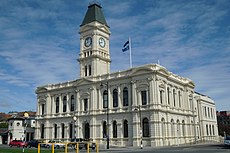
Oamaru is the largest town in North Otago, in the South Island of New Zealand, it is the main town in the Waitaki District. It is 80 kilometres (50 mi) south of Timaru and 120 kilometres (75 mi) north of Dunedin on the Pacific coast; State Highway 1 and the railway Main South Line connect it to both cities. With a population of 13,900, Oamaru is the 28th largest urban area in New Zealand, and the third largest in Otago behind Dunedin and Queenstown. The town is the seat of Waitaki District, which includes the surrounding towns of Kurow, Weston, Palmerston, and Hampden. which combined have a total population of 23,200.
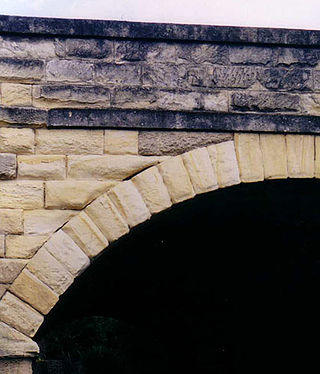
Oamaru stone, sometimes called whitestone, is a hard, compact limestone, quarried at Weston, near Oamaru in Otago, New Zealand.
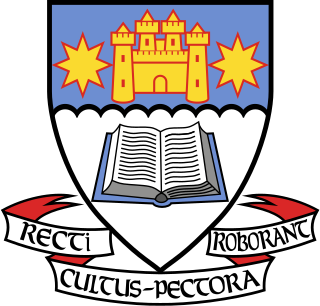
Otago Boys' High School (OBHS) is a secondary school in Dunedin, New Zealand. It is one of New Zealand's oldest boys' secondary schools. Originally known as Dunedin High School, it was founded on 3 August 1863 and moved to its present site in 1885. The main building was designed by Robert Lawson and is regarded as one of the finest Gothic revival structures in the country. Situated on high ground above central Dunedin it commands excellent views of the city and is a prominent landmark.
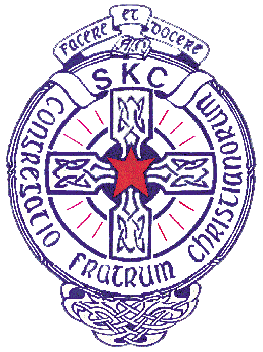
St Kevin's College in Oamaru, New Zealand, is a Catholic, coeducational, integrated, boarding and day, secondary school. It was founded by the Christian Brothers in 1927 for boys and became a co-educational school in 1983 when the Dominican Sisters closed down their school at Teschemakers. The College became a state integrated school in 1983. The Christian Brothers ceased to be on the teaching staff of the college in the late 1990s but remained the school's proprietor, and so appointed representatives to the college board, until 2019 when they transferred the ownership of St Kevin's College to the Bishop of Dunedin.

Moeraki is a small fishing village on the east coast of the South Island of New Zealand. It was once the location of a whaling station. In the 1870s, local interests believed it could become the main port for the north Otago area and a railway line, the Moeraki Branch, was built to the settlement and opened in 1877. However, the port could not compete with Oamaru and the lack of traffic as well as stability problems caused by difficult terrain led to the closure of the railway in 1879 after only two years' operation.

Heritage New Zealand Pouhere Taonga is a Crown entity with a membership of around 20,000 people that advocates for the protection of ancestral sites and heritage buildings in New Zealand. It was set up through the Historic Places Act 1954 with a mission to "...promote the identification, protection, preservation and conservation of the historical and cultural heritage of New Zealand" and is an autonomous Crown entity. Its current enabling legislation is the Heritage New Zealand Pouhere Taonga Act 2014.
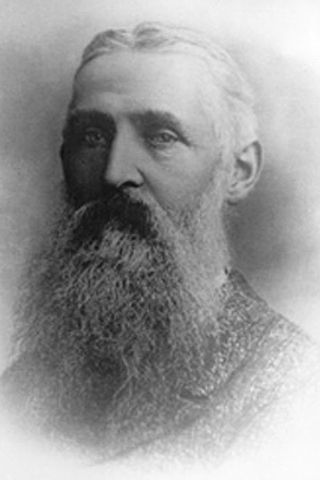
Sir William Jukes Steward was a New Zealand politician and the first Liberal Speaker of the New Zealand House of Representatives. He represented South Canterbury electorates in Parliament for a total of 34 years, before being appointed to the Legislative Council. He served briefly on the Otago Provincial Council and was Mayor of Oamaru for three years.

The University of Otago Registry Building, also known as the Clocktower Building, is a Victorian and later structure in the city of Dunedin, New Zealand. It stands next to the banks of the Water of Leith and is constructed from contrasting dark Leith Valley basalt and Oamaru stone, with a foundation of Port Chalmers breccia. The building houses the administrative centre of the university, and the office of the Vice-Chancellor. It has a Category I listing with Heritage New Zealand.

Oamaru Airport is an airport located 20 km north of Oamaru alongside State Highway 1, at Hilderthorpe in the North Otago region and the Waitaki District of New Zealand.
The architecture of New Zealand, though influenced by various cultures, expresses pre-dominantly European styles. Polynesian influences emerge in some areas.
Waitaki Boys' High School is a secondary school for boys located in the northern part of the town of Oamaru, Otago, New Zealand, with day and boarding facilities, and was founded in 1883. As of 2020, it has a school roll of approximately 400 students.
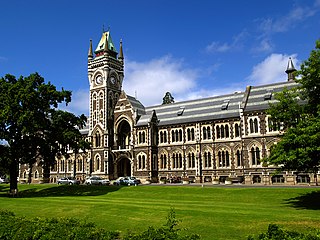
The University of Otago Clocktower complex is a group of architecturally and historically significant buildings in the center of the University of Otago campus. Founded in Dunedin, New Zealand, in 1869, the University of Otago was the expression of the province's Scottish founders' commitment to higher education. They were also the inheritors of a strong architectural tradition and gritty determination. Defending the decision to build inexpensive materials in an elaborate historicizing manner the Chancellor, Dr. D.M. Stuart, said "the Council had some old-world notions and liked to have a university with some architectural style". This attitude persisted for over fifty years and resulted in an impressive group of buildings.
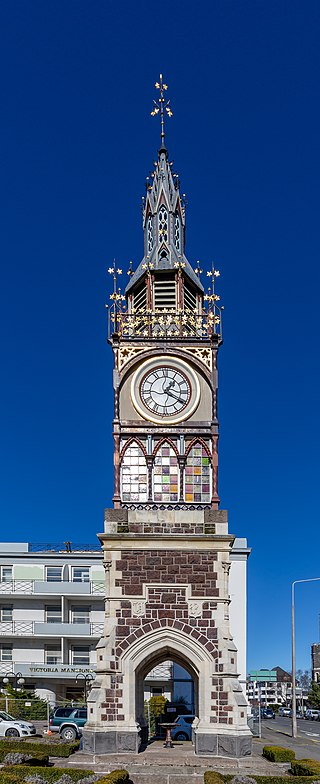
The Victoria Clock Tower, also known as the Diamond Jubilee Clock Tower, is a heritage-registered clock tower located in Christchurch, New Zealand. Designed by Benjamin Mountfort, it is registered as a "Historic Place – Category I" by the New Zealand Historic Places Trust.

The Chief Post Office or Christchurch Central Post Office, originally known as the Government Building, is located in Cathedral Square, Christchurch, New Zealand. The building was initially a post office with other government services. Until the 2011 Christchurch earthquake, it was a Visitor Information Centre but has since been inaccessible, but is planned to reopen in 2023 as The Grand a mixed use building that will include restaurants, shops, an office & a Visitor Information Centre. It was the site of the first telephone exchange in New Zealand. The structure is registered with Heritage New Zealand as a Category I heritage building.
William Barnett Armson was an architect, surveyor, engineer in colonial New Zealand. A co-founder of the Canterbury Association of Architects, and an architect to the provincial government, he established the architectural firm of Armson, Collins and Harman in 1870, which remained active until 1993. It was one of the two oldest architectural firms in New Zealand. His most important work was the Bank of New Zealand building in Dunedin.
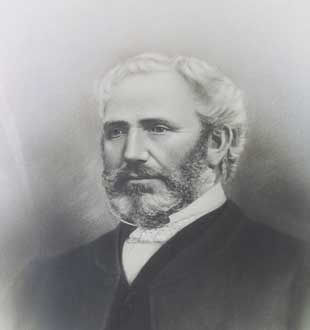
Allan McLean was a New Zealand runholder and philanthropist. Moving from Scotland to Australia as a child, and to New Zealand as an adult, he rose from a working class shepherd, to sheep rancher and a rich land holder. In his seventies, McLean built 'Holly Lea' in Christchurch, which was renamed McLean's Mansion. After his death, the building served as the McLean Institute through an act of parliament.

The Octagon, Christchurch, the former Trinity Church or Trinity Congregational Church designed by Benjamin Mountfort, later called the State Trinity Centre, is a Category I heritage building listed with Heritage New Zealand. Damaged in the 2010 Canterbury earthquake and red-stickered after the February 2011 Christchurch earthquake, the building was threatened with demolition like most other central city heritage buildings. In June 2012, it was announced that the building will be saved, repaired and earthquake strengthened.

John McLean was a runholder, first in Australia and then in New Zealand. From a poor background in Scotland, he and his brother Allan had the largest number of sheep in New Zealand. John McLean was also a politician, and he served on the Otago Provincial Council and the New Zealand Legislative Council.
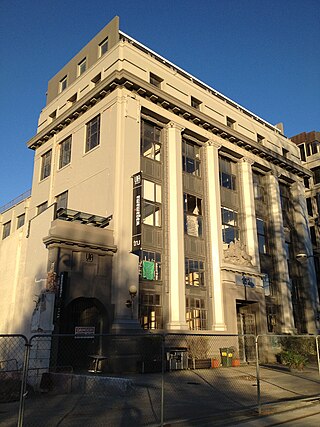
The Public Trust Building in Christchurch, New Zealand, is a heritage building designed by leading architect Cecil Wood that was threatened with demolition. It is now being restored for a range of office and hospitality tenants.

The Oamaru Opera House and former Town Hall in Oamaru is a historic building and current performance venue on the east coast of the South Island of New Zealand. The building is classified as a "Category I" historic place by Heritage New Zealand Pouhere Taonga, previously known as the New Zealand Historic Places Trust.
